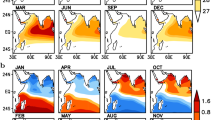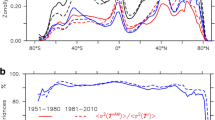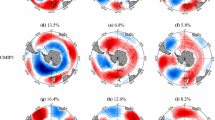Abstract
The observed interannual Indian Ocean sea surface temperature (SST) variability from 1950 to 2008 is analyzed in respect to the spatial structure of the variability. The analysis is based on an objective comparison of the leading empirical orthogonal function modes against the stochastic null hypothesis of spatial red noise (isotropic diffusion). Starting from this red noise assumption, the analysis searches for those structures that are most distinct from the red noise hypothesis. This objective approach will put previously well and less known modes of variability into the context of the multivariate SST variability. The Indian Ocean SST variability is marked by relatively weak SST variability, which is strongly dominated by a basin wide monopole pattern that is caused by different processes. The leading modes of variability are the El Nino Southern Oscillation (ENSO) variability and the warming trend, which both project onto the basin wide monopole structure. Other more characteristic spatial patterns of internal variability are much less dominant in the tropical Indian Ocean, which is quite different from all other ocean basin, where characteristic teleconnection patterns exist. The remaining, ENSO independent, detrended variability is dominated by multi-pole patterns from the southern Indian Ocean reaching into the tropical Indian Ocean, which are probably primarily caused by extra-tropical atmospheric forcings. The large scale tropical Indian Ocean internal variability itself has no dominant structure. The currently often used dipole mode index (DMI) does not appear to present a dominant teleconnection pattern of the Indian Ocean internal SST variability. In the context of the objective analysis presented here, the DMI partly reflects the ENSO variability and is also a representation of the multi-dimensional, chaotic spatial red noise (isotropic diffusion) process. As such the DMI cannot be interpreted as a coherent teleconnection between the two poles.













Similar content being viewed by others
References
Annamalai H, Liu P, Xie SP (2005) Southwest Indian Ocean SST variability: Its local effect and remote influence on Asian monsoons. J Clim 18:4150–4167
Bader J, Latif M (2003) The impact of decadal-scale Indian Ocean sea surface temperature anomalies on Sahelian rainfall and the North Atlantic Oscillation. Geophys Res Lett 30:2169
Baquero-Bernal A, Latif M, Legutke S (2002) On dipolelike variability of sea surface temperature in the tropical Indian Ocean. J Clim 15:1358–1368
Barnett TP, Pierce DW, AchutaRao KM, Gleckler PJ, Santer BD, Gregory JM, Washington WM (2005) Penetration of human-induced warming into the world’s oceans. Science 309:284–287
Behera SK, Rao SA, Saji HN, Yamagata T (2003) Comments on “A cautionary note on the interpretation of EOFs”. J Clim 16:1087–1093
Behera SK, Luo JJ, Masson S, Rao SA, Sakum H, Yamagata T (2006) A CGCM study on the interaction between IOD and ENSO. J Clim 19:1688–1705
Bjerknes J (1969) Atmospheric teleconnections from the equatorial Pacific. Mon Weather Rev 97:163–172
Bretherton CS, Widmann M, Dymnikov VP, Wallace JM, Blade I (1999) The effective number of spatial degrees of freedom of a time-varying field. J Clim 12:1990–2009
Compo GP, Sardeshmukh PD (2010) Removing ENSO-related variations from the climate record. J Clim (in press)
Deser C, Phillips AS, Hurrell JW (2004) Pacific interdecadal climate variability: linkages between the tropics and the North Pacific during boreal winter since 1900. J Clim 17:3109–3124
Dommenget D (2007) Evaluating EOF modes against a stochastic null hypothesis. Clim Dyn 28:517–531
Dommenget D, Latif M (2002) A cautionary note on the interpretation of EOFs. J Clim 15:216–225
Dommenget D, Latif M (2003) Comments on “A cautionary note on the interpretation of EOFs”—reply. J Clim 16:1094–1097
Dommenget D, Semenov V, Latif M (2006) Impacts of the tropical Indian and Atlantic Oceans on ENSO. Geophys Res Lett 33
Hannachi A, Dommenget D (2009) Is the Indian Ocean SST variability a homogeneous diffusion process? Clim Dyn 33:535
Hannachi A, Jolliffe IT, Stephenson DB (2007) Empirical orthogonal functions and related techniques in atmospheric science: a review. Int J Climatol 27:1119–1152
Hasselmann K (1976) Stochastic climate models. Part 1: theory. Tellus 28:473–485
Jansen MF, Dommenget D, Keenlyside N (2009) Tropical atmosphere-ocean interactions in a conceptual framework. J Clim 22:550–567
Jolliffe IT (2002) Principal component analysis. Springer series in statistics, 2nd edn. Springer, New York
Kalnay E, Kanamitsu M, Kistler R, Collins W, Deaven D, Gandin L, Iredell M, Saha S, White G, Woollen J, Zhu Y, Chelliah M, Ebisuzaki W, Higgins W, Janowiak J, Mo KC, Ropelewski C, Wang J, Leetmaa A, Reynolds R, Jenne R, Joseph D (1996) The NCEP/NCAR 40-year reanalysis project. Bull Am Meteorol Soc 77:437–471
Kug JS, Kang IS (2006) Interactive feedback between ENSO and the Indian Ocean. J Clim 19:1784–1801
Kug JS, Kang IS, Lee JY, Jhun JG (2004) A statistical approach to Indian Ocean sea surface temperature prediction using a dynamical ENSO prediction. Geophys Res Lett 31
Latif M, Barnett TP (1995) Interactions of the tropical Oceans. J Clim 8:952–964
Latif M, Dommenget D, Dima M, Grotzner A (1999) The role of Indian Ocean sea surface temperature in forcing east African rainfall anomalies during December–January 1997/98. J Clim 12:3497–3504
Li T, Wang B, Chang CP, Zhang YS (2003) A theory for the Indian Ocean dipole-zonal mode. J Atmos Sci 60:2119–2135
Mantua NJ, Hare SR, Zhang Y, Wallace JM, Francis RC (1997) A Pacific interdecadal climate oscillation with impacts on salmon production. Bull Am Meteorol Soc 78:1069–1079
Marshall J, Kushner Y, Battisti D, Chang P, Czaja A, Dickson R, Hurrell J, McCartney M, Saravanan R, Visbeck M (2001) North Atlantic climate variability: phenomena, impacts and mechanisms. Int J Climatol 21:1863–1898
Moller J, Dommenget D, Semenov VA (2008) The annual peak in the SST anomaly spectrum. J Clim 21:2810–2823
Monahan AH, Fyfe JC, Ambaum MHP, Stephenson DB, North GR (2009) Empirical orthogonal functions: the medium is the message. J Clim 22:6501–6514
Nicholls N (1989) Sea surface temperature and Australian winter rainfall. J Clim 2:965–973
North GR, Bell TL, Cahalan RF, Moeng FJ (1982) Sampling errors in the estimation of empirical orthogonal functions. Mon Weather Rev 110:699–706
Penland C, Matrosova L (2006) Studies of El Nino and interdecadal variability in tropical sea surface temperatures using a nonnormal filter. J Clim 19:5796–5815
Rayner NA, Parker DE, Horton EB, Folland CK, Alexander LV, Rowell DP, Kent EC, Kaplan A (2003) Global analyses of sea surface temperature, sea ice, and night marine air temperature since the late nineteenth century. J Geophys Res Atmos 108
Richman MB (1986) Rotation of principal components. J Climatol 6:293–335
Saji NH, Goswami BN, Vinayachandran PN, Yamagata T (1999) A dipole mode in the tropical Indian Ocean. Nature 401:360–363
Schott FA, Xie SP, McCreary JP (2009) Indian Ocean circulation and climate variability. Rev Geophys 47
Shinoda T, Alexander MA, Hendon HH (2004) Remote response of the Indian Ocean to interannual SST variations in the tropical Pacific. J Clim 17:362–372
Ummenhofer CC, Sen Gupta A, Pook MJ, England MH (2008) Anomalous rainfall over southwest Western Australia forced by Indian Ocean sea surface temperatures. J Clim 21:5113–5134
Venzke S, Latif M, Villwock A (2000) The coupled GCM ECHO-2. Part II: Indian Ocean response to ENSO. J Clim 13:1371–1383
Weare BC (1979) Statistical study of the relationships between Ocean surface temperatures and the Indian Monsoon. J Atmos Sci 36:2279–2291
Webster PJ, Moore AM, Loschnigg JP, Leben RR (1999) Coupled ocean-atmosphere dynamics in the Indian Ocean during 1997–98. Nature 401:356–360
Wu RG, Kirtman BP (2004) Understanding the impacts of the Indian Ocean on ENSO variability in a coupled GCM. J Clim 17:4019–4031
Zebiak SE (1993) Air-sea interaction in the equatorial Atlantic region. J Clim 6:1567–1568
Acknowledgments
I like to thank Abdel Hannachi, and Noel Keenlyside for discussions and comments. This work was supported by the Deutsche Forschungsgemeinschaft (DFG) through the project DO1038/2-1.
Author information
Authors and Affiliations
Corresponding author
Rights and permissions
About this article
Cite this article
Dommenget, D. An objective analysis of the observed spatial structure of the tropical Indian Ocean SST variability. Clim Dyn 36, 2129–2145 (2011). https://doi.org/10.1007/s00382-010-0787-1
Received:
Accepted:
Published:
Issue Date:
DOI: https://doi.org/10.1007/s00382-010-0787-1




